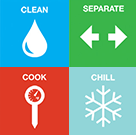Foodborne Germs and Illnesses
Some Important Foodborne Germs
The top five germs that cause illnesses from food eaten in the United States are Norovirus, Salmonella, Clostridium perfringens, Campylobacter, and Staphylococcus aureus (Staph).
Some other germs don’t cause as many illnesses, but when they do, the illnesses are more likely to lead to hospitalization. Those germs include Clostridium botulinum, the germ that causes botulism; Listeria; Shiga toxin-producing Escherichia coli (E. coli) O157; and Vibrio.
For a more complete list of foodborne germs, see the Foodborne Illness A-Z Index
CDC estimates that each year 48 million people get sick from a foodborne illness, 128,000 are hospitalized, and 3,000 die. Many different disease-causing germs can contaminate foods, so there are many different foodborne infections.
What Causes Food Poisoning?
Researchers have identified more than 250 foodborne diseases. Most of them are infections, caused by a variety of bacteria, viruses, and parasites. Harmful toxins and chemicals also can contaminate foods and cause foodborne illness.
Do I Have Food Poisoning?
Common symptoms of foodborne diseases are nausea, vomiting, stomach cramps, and diarrhea. However, symptoms may differ among the different types of foodborne diseases. Symptoms can sometimes be severe and some foodborne illnesses can even be life-threatening. Although anyone can get a foodborne illness, some people are more likely to develop one. Those groups include:
- Young children
- Older adults
- Pregnant women
- People with immune systems weakened from medical conditions, such as diabetes, liver disease, kidney disease, organ transplants, HIV/AIDS, or from receiving chemotherapy or radiation treatment.
Most people with a foodborne illness get better without medical treatment, but people with severe symptoms should see their doctor.
How Can I Keep Food Safe?

Anyone can get sick from eating contaminated food. Learn the four simple food safety steps – clean, separate, cook, and chill – to lower your chance of food poisoning and to protect yourself and your loved ones.
- Page last reviewed: July 24, 2017
- Page last updated: August 31, 2017
- Content source:


 ShareCompartir
ShareCompartir
